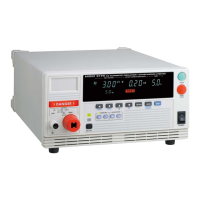9.3 Communication Methods
130
Separators
Header Separator
In a message containing multiple data items, commas are required to separate
the data items from one another.
Data Separator
In a message containing multiple data items, commas are required to separate
the data items from one another.
Data Formats
The instrument uses character data and decimal numeric data, depending on the
command.
Character Data
Character data always begins with an alphabetic character, and subsequent
characters may be either alphabetic or numeric. Character data is not case-sen-
sitive, although response messages from the instrument are only upper case.
Similar to Command Syntax, both long form and short form are acceptable.
Decimal Numeric Data
Three formats are used for numeric data, identified as NR1, NR2 and NR3.
Numeric values may be signed or unsigned. Unsigned numeric values are han-
dled as positive values.
Values exceeding the precision handled by the instrument are rounded to the
nearest valid digit.
NR1 .......Integer data e.g.: +12, -23, 34
NR2 .......Fixed-point data e.g.: +1.23, -23.45, 3.456
NR3 .......Floating-point exponential representation data e.g.: +1.0E-2, -2.3E+4
The term "NRf format" includes all three of the above numeric decimal formats.
The instrument accepts NRf format data.
The format of response data is specified for each command, and the data is sent
in that format.
:ESR0 10
:CONFigure:WITHstand:CLOWer 0.1
The instrument does not fully support IEEE 488.2. As much as possible, please
use the data formats shown in the Reference section.
Also, be careful to avoid constructing single commands that could overflow the
input buffer or output queue.
:MODE MWITH
:WITHstand:CLOWer ON

